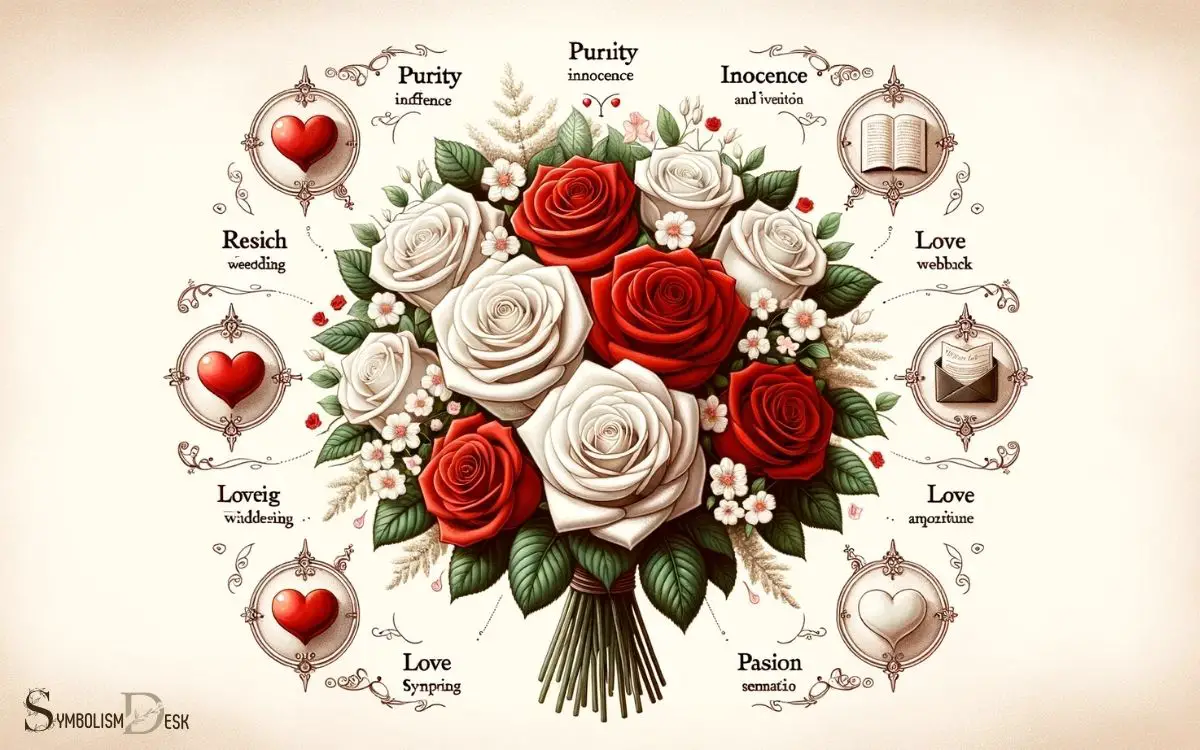What is the Symbolic Meaning of White And Red Roses? Love!
White roses symbolize purity, innocence, and new beginnings, while red roses represent deep love, passion, and respect. These flowers hold significant meaning in various cultural and social contexts.
The symbolic significance of white and red roses extends back centuries and varies across different cultures:
- White Roses: They are often associated with weddings and are seen as a sign of new starts and fidelity. In some cultures, white roses also signify remembrance and reverence.
- Red Roses: Universally known to symbolize romantic love, they are a traditional Valentine’s Day gift. Red roses also convey respect and admiration, making them appropriate for tributes.
Embrace the timeless elegance of white and red roses, each telling its own story of love, purity, and devotion.

Key Takeaway
7 Aspects: Symbolic Meanings of White and Red Roses
| Aspect | White Roses | Red Roses |
|---|---|---|
| Love | Pure love, innocence, and charm | Love, romance, and deep passion |
| Friendship | True friendship, respect, and hope | Not typically represented |
| Apology | Purity and sincerity of intentions | Intense regret and desire for forgiveness |
| Celebration | Worthiness and reverence | Congratulations and hearty wishes |
| Sympathy | Reverence, humility, heir of innocence | Respect, courage, and love |
| Spirituality | Spiritual love, divine purity | Sacrificial love, respect for the departed |
| Marriage | True love, purity, and innocence | Love, passion, and congratulations |
Historical Significance of White Roses
White roses have held historical significance since ancient times as symbols of purity, innocence, and spirituality.
In ancient Greece, they were associated with the goddess of love, Aphrodite, and were often used in her worship. During the Roman Empire, white roses were linked to the goddess Venus and were used in rituals and offerings.
In Christianity, the white rose became a symbol of the Virgin Mary’s purity and motherly love. Moreover, during the War of the Roses in 15th-century England, the white rose was the symbol of the House of York, representing peace and unity.
Throughout history, white roses have been revered for their timeless representation of purity and spirituality, making them a powerful and enduring symbol in various cultures and traditions.
Cultural Symbolism of Red Roses
The cultural symbolism of red roses dates back centuries, with their vibrant hue representing love, passion, and romance in various societies and traditions.
The significance of red roses varies across cultures:
- In Western cultures, red roses symbolize deep love and affection.
- In Eastern cultures, red roses are associated with good fortune and happiness.
- In Christianity, red roses are linked to the blood of martyrs and signify the ultimate sacrifice and love.
- In Hinduism, red roses are offered to gods as a symbol of devotion and purity.
- In ancient Greek and Roman mythology, red roses were tied to the goddess of love, Aphrodite or Venus, further solidifying their association with love and desire.
These diverse cultural interpretations highlight the universal appeal of red roses as a symbol of love and passion.
Meanings of White Roses in Different Contexts
Associated with purity and reverence, white roses often convey a sense of innocence and spirituality in various cultural and ceremonial contexts.
In weddings, they symbolize new beginnings, purity of love, and unity, making them a popular choice for bridal bouquets and decorations.
Within religious ceremonies, white roses represent spirituality, virtue, and the divine. They’re often used to adorn altars and offer a sense of serenity and holiness.
Additionally, white roses are commonly associated with sympathy and remembrance, making them a fitting choice for funerals and memorials, where they convey respect, honor, and eternal love for the departed.
Their versatile symbolism allows white roses to transcend cultural boundaries and hold significant meaning in a variety of contexts.
Symbolic Interpretations of Red Roses
Red roses are universally recognized as a symbol of romantic love, making them a popular choice for expressing affection and desire.
Their vibrant red hue is often associated with passion and intense emotions, further solidifying their representation of love and longing.
Understanding the symbolic interpretations of red roses can provide insight into the depth of meaning behind this timeless flower.
Romantic Love Symbolism
Romantic love symbolism is often attributed to red roses due to their association with passion, desire, and romantic love. The deep red color of the roses has become a universal symbol of love and affection, making them a popular choice for expressing romantic feelings.
The following are some symbolic interpretations of red roses:
- Passionate Love: Red roses symbolize intense and passionate love, expressing deep emotions and desire.
- Romance: They’re a classic representation of romantic love, often given as a token of affection and devotion.
- Longing and Desire: Red roses convey a sense of longing and yearning for the presence of a loved one.
- Beauty and Sensuality: The velvety petals of red roses evoke feelings of beauty, sensuality, and allure.
- Commitment: In relationships, red roses symbolize commitment and the promise of everlasting love.
Passion and Desire Representation
The essence of passion and desire is deeply embedded in the symbolic interpretations of red roses, conveying intense emotions and a yearning for romantic connection.
Red roses have long been associated with passion, desire, and love. They symbolize deep affection, longing, and sensuality.
The vibrant red color of the roses is often linked to the fiery nature of passionate love, igniting feelings of desire and romance.
In art and literature, red roses are frequently used to symbolize ardor, representing the intense emotional connection between lovers.
Their rich color and velvety texture evoke a sense of warmth and desire, capturing the essence of romantic yearning.
As the symbolism of red roses embodies such intense emotions, it sets the stage for exploring the contrasting representations of white roses in art and literature. While red roses often signify passion, love, and desire, white roses traditionally convey purity, innocence, and new beginnings. This juxtaposition highlights the nuanced symbolic meaning of color roses, showcasing how each hue carries its own distinct narrative in creative expression. By examining these contrasts, one can uncover deeper insights into how different cultures and societies assign emotional weight to color.
White Roses in Art and Literature
White roses have long been associated with purity and innocence, making them a popular subject in art and literature.
Their symbolism in various cultures and traditions adds depth and significance to their portrayal in creative works.
From ancient mythology to modern poetry, white roses have held a prominent place in the literary and artistic expressions of love, beauty, and virtue.
White Roses as Purity
In art and literature, white roses are often depicted as a symbol of purity. They’ve been used to convey the concept of purity in various forms of creative expression, including paintings, poetry, and prose.
White roses symbolize purity in the following ways:
- Innocence: White roses are commonly associated with innocence, representing the purity and naivety of the soul.
- Virginity: They’re often used to symbolize the purity and chastity of a woman, particularly in romantic literature.
- Spiritual Purity: White roses are also used to convey spiritual purity and the divine presence in religious art and writings.
- Purity of Love: In romantic contexts, white roses symbolize pure and undying love, free from ulterior motives.
- Hope and New Beginnings: They’re also seen as a symbol of hope and new beginnings, representing a clean slate and fresh start.
Symbolism in White Roses
Symbolic depictions of white roses frequently appear in art and literature, often portraying purity and innocence with a touch of subtlety and nuance.
In art, white roses are commonly used to symbolize purity, spirituality, and transcendence. For instance, they’re often depicted in religious paintings to represent the Virgin Mary’s purity.
In literature, white roses have been used to convey various themes, such as love, loss, and even political movements.
For example, in Shakespeare’s works, white roses are often associated with purity and innocence, while in modern literature, they may symbolize hope and new beginnings.
White Roses in Literature
Depicted in various forms of artistic expression and literature, white roses have conveyed themes such as purity, spirituality, and transcendence.
In literature, white roses have been used to symbolize a range of ideas and emotions:
- Innocence and purity
- New beginnings and hope
- Love and devotion
- Loss and mourning
- Spiritual enlightenment
Authors and poets have employed white roses as powerful symbols to evoke deep emotions and convey profound messages in their works.
From Shakespearean sonnets to modern novels, white roses have served as a versatile literary tool, enriching the depth and meaning of the written word. This versatile symbolism has contributed to the enduring popularity of white roses in literature.
Transitioning into the subsequent section about ‘red roses in mythology and legends’, red roses have also held significant symbolic meanings across various cultures and time periods.
Red Roses in Mythology and Legends
Throughout mythology and legends, red roses have been revered as symbols of love, passion, and beauty.
In Greek mythology, red roses are associated with Aphrodite, the goddess of love and beauty, and are said to have sprung from her tears and the blood of her beloved Adonis.
In Roman mythology, red roses are linked to Venus, the goddess of love, and were used in her festivals as a symbol of passion.
Additionally, Christian legend attributes the red rose to the blood of martyrs and symbolizes the love of Christ.
In these myths and legends, the red rose consistently represents deep emotions, desire, and devotion, making it a powerful and enduring symbol of love and beauty across diverse cultures and traditions.
Contemporary Symbolism of White and Red Roses
White and red roses continue to hold significant contemporary symbolism in various cultural and societal contexts.
In today’s society, these flowers represent:
- Love and Romance: Red roses are still a classic symbol of love and passion, often given as a romantic gesture.
- Purity and Innocence: White roses are used to symbolize purity, innocence, and spiritual love in weddings and other ceremonies.
- Remembrance: Both white and red roses are used to honor and remember loved ones who’ve passed away.
- Unity and Peace: White and red roses together can symbolize unity and harmony, making them popular choices for weddings and peace events.
- Political and Social Movements: Red and white roses have been used to symbolize various political and social movements, representing ideals such as equality, justice, and freedom.
Conclusion
The symbolic meanings of white and red roses are deeply rooted in history, culture, and art. Whether used in different contexts or interpreted in various mythologies, these roses continue to hold significant meanings in contemporary society.
Their timeless symbolism coincides with the universal themes of love, purity, and passion, making them a powerful and evocative symbol that resonates with people across the world.






